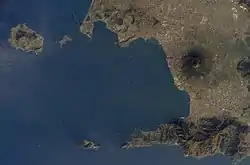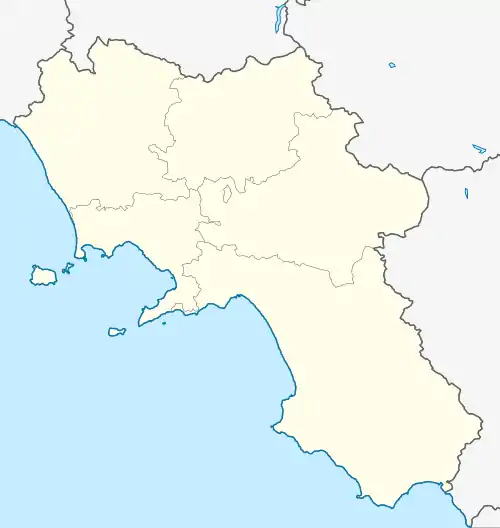Metropolitan City of Naples
The Metropolitan City of Naples (Italian: Città metropolitana di Napoli) is an Italian metropolitan city in Campania region.
Metropolitan City of Naples
Città metropolitana di Napoli | |
|---|---|
 Aerial view of the Metropolitan City of Naples | |
 Flag  Coat of arms | |
 Metropolitan City of Naples  Metropolitan City of Naples | |
| Coordinates: 40.8333°N 14.2500°E | |
| Country | |
| Region | Campania |
| Established | 1 January 2015 |
| Capital(s) | Naples |
| Comuni | 92 |
| Government | |
| • Metropolitan Mayor | Gaetano Manfredi |
| Area | |
| • Total | 1,171.13 km2 (452.18 sq mi) |
| Population (2022) | |
| • Total | 2,969,571 |
| • Density | 2,500/km2 (6,600/sq mi) |
| Time zone | UTC+1 (CET) |
| • Summer (DST) | UTC+2 (CEST) |
| Postal code | 80121-80147 (cap) 80010-80079 (rest) |
| Telephone prefix | 081 |
| Vehicle registration | NA |
| ISTAT | 263 [1] |
| Website | www |
It was established on 1 January 2015. Its capital city is Naples; within the city there are 92 comunes (municipalities).[2][3] It was first created by the reform of local authorities (Law 142/1990) and established by Law 56/2014, thus replacing the Province of Naples in 2015.
The Metropolitan City of Naples is headed by the metropolitan mayor (sindaco metropolitano) and the metropolitan council (consiglio metropolitano). Since 18 October 2021, its head has been Gaetano Manfredi, mayor of the capital city.
Demography and territory
.svg.png.webp)
The city is 96th out of 110 Italian provinces and metropolitan cities by landmass, with an area (1,171 km2 including islands) that is smaller than the core comune of Rome (1,287 km2).[4] Naples is, however, Italy's third largest metropolitan city by population, making it one of the most densely populated areas in Europe; the metropolitan region also includes the municipality of Casavatore, the highest-density municipality in Italy (at 12,000 inhabitants/km2). While it contains more than half of Campania's population, it only occupies 8.6% of Campania's landmass (13,590 km2), creating a strong demographic and territorial imbalance with the other four provinces in Campania.
Municipalities (comune) in the Metropolitan City vary in size, ranging from 1.62 km2 (Casavatore) to 117.27 km2 (Naples); 60% of the municipalities are small (less than or equal to 10 km2), 36% of medium-sized (> 10 km2 and ≤ 25 km2), the rest (11%) more than 25 km2 and, of this, only two municipalities (Acerra and Giugliano) are between 50 and 100 km2 and only the municipality of Naples exceeds 100 km2.
Because of its proximity to Vesuvius and Phlegraean Fields, the city is vulnerable to seismic and volcanic activity.
Largest municipalities

| Rank | City | Population | Area (km2) |
Density (inhabitants/km2) |
Altitude (mslm) |
|---|---|---|---|---|---|
| 1st | Naples | 959,062 | 117,27 | 8178.2 | 17 |
| 2nd | Giugliano in Campania | 118,821 | 94.19 | 1261.5 | 97 |
| 3rd | Torre del Greco | 87,575 | 30.66 | 2856.3 | 43 |
| 4th | Pozzuoli | 83,412 | 43.21 | 1930.4 | 28 |
| 5th | Casoria | 79,542 | 12.03 | 6612 | 60 |
| 6th | Castellammare di Stabia | 64,553 | 17.71 | 3645 | 6 |
| 7th | Afragola | 63,935 | 17.99 | 3553.9 | 43 |
| 8th | Acerra | 59,483 | 54.08 | 1099.9 | 26 |
| 9th | Marano di Napoli | 59,470 | 15.45 | 3849.2 | 151 |
| 10th | Ercolano | 54,707 | 19.64 | 2785.5 | 44 |
| 11th | Portici | 53,888 | 4.12 | 13079.6 | 29 |
Government
Metropolitan Council
Metropolitan Cities give large urban areas the administrative powers of a province, a system designed to improve local administration, create efficiency in spending, and better coordinate basic services (including transport, school and social programs) and environment protection.[5] The Mayor of Naples thus also has powers as Metropolitan Mayor, presiding over a Metropolitan Council formed by 24 mayors of municipalities (comune) within the Metropolitan City.
The first Metropolitan Council of the City was elected on 28 September 2014.The current Metropolitan Council of the City was elected on 13 March 2022:
| Group | Seats | |
|---|---|---|
| PD • SI • EV | 14 / 24 | |
| M5S | 3 / 24 | |
| FI | 3 / 24 | |
| FdI | 1 / 24 | |
| L | 1 / 24 | |
| A | 1 / 24 | |
| Others | 1 / 24 | |
List of Metropolitan Mayors of Naples
| Metropolitan Mayor | Term start | Term end | Party | |
|---|---|---|---|---|
| 1 | Luigi de Magistris | 1 January 2015 | 18 October 2021 | DemA |
| 2 | Gaetano Manfredi | 18 October 2021 | Incumbent | Ind |
Economy
In 2020 Naples' gross metropolitan product was €56.3 billion. This puts Naples in 43rd place among cities in European Union.[6]
Tourism

The area is particularly fruitful for tourism, both national and international. Pompeii, the excavated Roman city which was destroyed by Mount Vesuvius in 79 AD is among the most popular destinations in all of Italy.[7] Three islands in the Gulf of Naples are also prominent destinations; Ischia, Procida, part of the Phlegrean Islands, and Capri. Together they are also known as the Campanian Archipelago. On Capri, there is the famous Blue Grotto; inside the grotto the sea seems to be lit from underwater, it is a magnificent blue colour, hence its name.[8]
The Sorrentine Peninsula (and its main town Sorrento) has long been a popular destination for tourism, it is well known for the drink Limoncello and its luxurious sea cliffs. It is rich with villas, castles, guard towers, churches, and in Vico Equense ancient farmhouses.[9]
Sport
The most popular sport in the metropolitan city is football. This area was one of the first in Southern Italy to start playing sports, when English sailors brought them in during the early 1900s. The most successful club from the province are by far SSC Napoli, who have won Serie A (the Italian Championship) twice and the UEFA Cup while Diego Maradona was with the club.
At present there are four professional football clubs playing within the Italian leagues from the province; in Serie A there is SSC Napoli, while in Lega Pro the province is represented by SS Ischia Isolaverde, SS Juve Stabia and AC Savoia.
References
- codes of metropolitan cities from January 2015 - istat.it
- Craveri, Pietro (17 February 2015). "Città metropolitana, lo statuto è di là da venire". Retrieved 25 February 2015.
- Upinet.it Archived 2007-08-07 at the Wayback Machine
- The metropolitan city is an historic challenge (page 16)
- Vittorio Ferri (2009). "Metropolitan cities in Italy. An institution of federalism". University of Milan-Bicocca. Retrieved 23 May 2011.
{{cite journal}}: Cite journal requires|journal=(help) - "EU regions by GDP, Eurostat".
- ItalianCookingandLiving Archived 2003-08-29 at the Wayback Machine
- "Italia.it". Archived from the original on 2007-03-25. Retrieved 2007-06-26.
- SorrentoTourism.com Archived 2007-06-10 at the Wayback Machine

